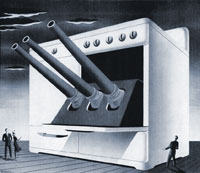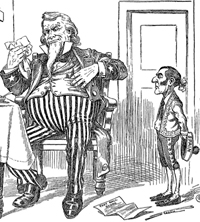Paul Conrad: Drawing Fire
This documentary presents a tribute to the three-time Pulitzer Prize-winning editorial cartoonist Paul Conrad and his half-century career.
This documentary presents a tribute to the three-time Pulitzer Prize-winning editorial cartoonist Paul Conrad and his half-century career.

I am looking for an electronic copy of a cartoon which shows most of the different aspects of the home front effort in America during World War II.
America’s home front effort included recruiting for the military, participating in scrap drives, paying income taxes, buying war bonds, using rationing coupons, planting Victory gardens, encouraging sanitation, volunteering for civil defense work, increasing public morale, and participating in industrial retooling and production. The Hollywood studios that were making cartoons at the beginning of the war were quickly drafted into turning their art to the war effort, to mobilize the American public. Cartoons were just one part of a propaganda effort, which also included the production and distribution of feature films, posters, war-themed commercial radio, newspaper and magazine advertising, the organization of celebrity tours and war bond drives, the establishment of censorship offices, and the formulation and distribution of a barrage of information and directives from various government officials and agencies.
Leon Schlesinger Productions produced popular cartoons featuring Daffy Duck and Bugs Bunny for Warner Brothers Studios, many of which had war themes, such as “The Ducktators” (1942), “Confusions of a Nutzy Spy” (1943), “The Fifth Column Mouse” (1943), “Tokio Jokio” (1943), “Daffy—The Commando” (1943), “Falling Hare” (1943), and “Draftee Daffy” (1945).
At least two of these Warner Brothers’ cartoons focused on home front activities and might be the cartoon you’re thinking of: “Scrap Happy Daffy” (1943), and ”Wacky Blackout” (1942).
Walt Disney also produced many war-themed cartoons with Mickey, Donald, Goofy and the rest of the gang, some of which were focused on the home front, such as “Out of the Frying Pan into The Firing Line” (1942), and ”Food Will Win the War” (1942).
A collection of short cartoons and movies from the Disney Studio during World War II, which includes many intended for the home front, was released (for purchase) in 2004 as a 2-disc DVD, “On the Front Lines,” in the series “Walt Disney Treasures.” This collection includes such titles as “Donald Gets Drafted” (1942), “Private Pluto” (1943), “Home Defense” (1943), “All Together” (1942), “Defense Against Invasion” (1943), and “Cleanliness Brings Health” (1945), as well as many others. The collection also includes Disney’s 1943 animated film, “Victory Through Air Power,” as well as a few of the hundreds of training films that the Disney studio made for the War Department or the National Film Board of Canada, such as “Four Methods of Flush Riveting” (1942).
Clayton R. Koppes and Gregory D. Black, Hollywood Goes to War: How Politics, Profits and Propaganda Shaped World War II Movies. Berkeley: University of California Press, 1990.
Thomas Doherty, Projections of War: Hollywood, American Culture, and World War II. New York: Columbia University Press, 1999.
James J. Kimble, Mobilizing the Home Front. College Station: Texas A&M University Press, 2006.
Steven Watts, The Magic Kingdom: Walt Disney and the American Way of Life. Boston: Houghton Mifflin, 1997.
Cass Warner-Sperling, Cork Millner, and Jack Warner. Hollywood Be Thy Name: The Warner Brothers Story. Lexington: University Press of Kentucky, 1999.

Bringing together a wealth of material from libraries, archives, and museums, this website examines the history and culture of the state of Georgia. Legal materials include more than 17,000 state government documents from 1994 to the present, updated daily, and a complete set of Acts and Resolutions from 1799 to 1995. "Southeastern Native American Documents" provides approximately 2,000 letters, legal documents, military orders, financial papers, and archaeological images from 17301842. Materials from the Civil War era include a soldier's diary and two collections of letters.
The site provides a collection of 80 full-text, word-searchable versions of books from the early 19th century to the 1920s and three historic newspapers. There are approximately 2,500 political cartoons from 1946-1982; Jimmy Carter's diaries; photographs of African Americans from Augusta during the late 19th century; and 1,500 architectural and landscape photographs from the 1940s to the 1980s.

The 150 cartoons presented here were drawn between 1929 and 2000 by three-time Pulitzer Prize-winning political cartoonist Herblock (Herbert Block). Cartoons comment on major events and public issues.
The website also presents an essay by Block on "the cartoon as an opinion medium"; a biographical essay; and 15 caricatures of the cartoonist by well-known colleagues. Cartoons are organized according to 13 chronological sections, with an additional segment devoted to presidents. Brief annotations provide historical context for each image.
A tribute site by the Washington Post, Herblock's longtime employer, offers additional cartoons and essays by Block.
Eighth grade American history educator Eric Langhorst discusses two books—The Political Cartoons of the Whispering Gallery by the Lincoln Presidential Library and Museum and The Lines are Drawn: Political Cartoons of the Civil War, edited by Kristen M. Smith—that he uses to give students an understanding that Abraham Lincoln was viewed in many different lights during his own time.
Uncle Sam and Lady Liberty—for over a century, these two characters have personified the United States and popular conception of the nation’s ideals. Answer these questions about the roles these characters have played, including soldier, tyrant, police officer, financier, judge, deity, and champion of the oppressed.
1. What characters have political cartoonists used to represent the English counterparts to Uncle Sam and Lady Liberty?
c. John Bull and Britannia.
 Wearing breeches and a Union Jack waistcoat, John Bull once served as the symbol for the British everyman, but evolved into a symbol of the country as a whole. Both Britannia, the goddess-like female figure of England, and John Bull often appeared in political cartoons with Uncle Sam or Columbia—another name for Lady Liberty.
Wearing breeches and a Union Jack waistcoat, John Bull once served as the symbol for the British everyman, but evolved into a symbol of the country as a whole. Both Britannia, the goddess-like female figure of England, and John Bull often appeared in political cartoons with Uncle Sam or Columbia—another name for Lady Liberty.
2. This version of Uncle Sam appeared in a Denver Evening Post cartoon in November 1898. Uncle Sam is usually drawn as a skinny character. Why is he fat here?
b. He has just finished consuming overseas territories, such as Hawaii, Puerto Rico and the Philippines.
 In a spree of imperialism, the United States, represented by Uncle Sam, has "consumed" Hawaii (annexed to the U.S. on July, 1898), as well as Puerto Rico and the Philippines (though the Treaty of Paris and the acquisition of these as territories was still in debate in November 1898). Now, Uncle Sam turns to the figure of Spain—the cartoon's caption has him say, "Now, young man, I'll attend to your case." With the Spanish-American War over, the glutted U.S. prepares to attend to Spain itself, not just its colonies.
In a spree of imperialism, the United States, represented by Uncle Sam, has "consumed" Hawaii (annexed to the U.S. on July, 1898), as well as Puerto Rico and the Philippines (though the Treaty of Paris and the acquisition of these as territories was still in debate in November 1898). Now, Uncle Sam turns to the figure of Spain—the cartoon's caption has him say, "Now, young man, I'll attend to your case." With the Spanish-American War over, the glutted U.S. prepares to attend to Spain itself, not just its colonies.
3. When did political cartoonists draw Uncle Sam as a self-appointed global policeman?
d. During the "Imperialist" phase of U.S. foreign affairs, beginning prior to the Spanish-American War.
 In the years leading up to the Spanish-American War and the U.S. metamorphosis into an imperialist world power, Uncle Sam was often drawn as a police officer. However, cartoonist Thomas Nast had already pictured Uncle Sam as a cop on the beat, policing U.S. political corruption, as early as 1888.
In the years leading up to the Spanish-American War and the U.S. metamorphosis into an imperialist world power, Uncle Sam was often drawn as a police officer. However, cartoonist Thomas Nast had already pictured Uncle Sam as a cop on the beat, policing U.S. political corruption, as early as 1888.
4. When Uncle Sam first appeared, he was drawn to resemble:
a. An old gentleman in knee breeches.
 For several decades, Uncle Sam was indistinguishable from an earlier character, Brother Jonathan, who also represented the U.S., superceding Yankee Doodle. By the middle of the 19th century, the same figure-by then clad in striped pants, short jacket, and top hat—was sometimes called Uncle Sam and sometimes Brother Jonathan. By about 1875, "Brother Jonathan" had mostly disappeared.
For several decades, Uncle Sam was indistinguishable from an earlier character, Brother Jonathan, who also represented the U.S., superceding Yankee Doodle. By the middle of the 19th century, the same figure-by then clad in striped pants, short jacket, and top hat—was sometimes called Uncle Sam and sometimes Brother Jonathan. By about 1875, "Brother Jonathan" had mostly disappeared.
5. When Columbia first appeared, she most closely resembled:
a. The goddess of liberty, Libertas.
 Often depicted in the French Revolution, Libertas wore a soft "liberty" or "Phrygian" cap. As Columbia, she could also wear feathers on her head, a reference to Native Americans, or a star or crown. The name "Columbia" fell out of popularity after World War I, and the character gained the names "Miss Liberty" or "Lady Liberty."
Often depicted in the French Revolution, Libertas wore a soft "liberty" or "Phrygian" cap. As Columbia, she could also wear feathers on her head, a reference to Native Americans, or a star or crown. The name "Columbia" fell out of popularity after World War I, and the character gained the names "Miss Liberty" or "Lady Liberty."
The Library of Congress, as part of its American Treasures exhibit, looks at the history of the famous "I Want You" World War I image of Uncle Sam. It also showcases an image, by the same artist, of Lady Liberty.
Uncle Sam and Lady Liberty have appeared regularly in political cartoons since their creation. Vassar College's 1896: The Presidential Campaign includes a subsection just for cartoons containing Uncle Sam, as does Leo Robert Klein's The Red Scare (1918-1921) (see "Uncle Sam" under subject headings). Even Dr. Seuss took his turn drawing Uncle Sam: Try June 1942 in Dr. Seuss Went to War: A Catalog of Political Cartoons. You might also try a search for the term "uncle sam" in the New York Public Library's Digital Archive.
Once you've found some resources picturing these iconic personifications, take a look at Understanding and Interpreting Political Cartoons in the History Classroom for models of classroom use.







The Democratic political machine was a favorite target of political cartoonists in the late 19th century. Josh Brown of the American Social History Project looks at one particular cartoon about New York's notorious Boss Tweed.
This feature is no longer available.
An early environmentalist cartoon shows the disgusting results of pollution in New York City harbor.
This feature is no longer available.
Anti-immigration feelings are captured in an 1891 cartoon that highlights Jewish and Italian immigration. Cartoon historian Josh Brown of the American Social History Project explains.
This feature is no longer available.
A cartoon that shows two sides of millionaire philanthropist Andrew Carnegie is explained by Josh Brown of the American Social History Project.
This feature is no longer available.